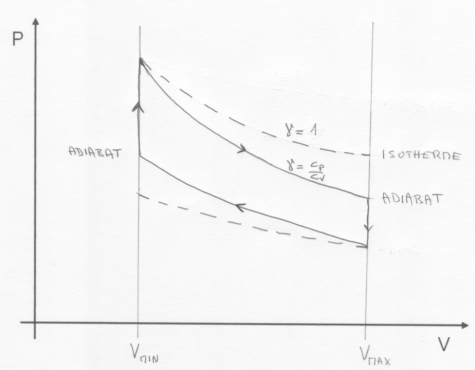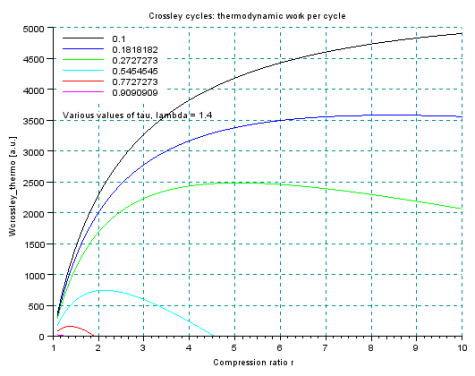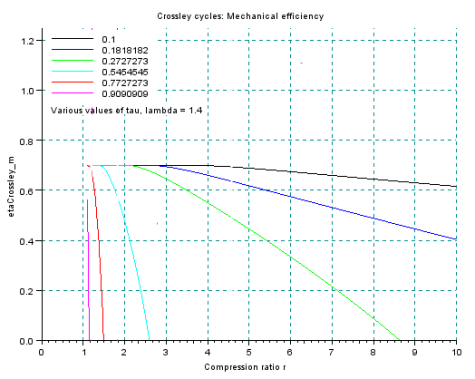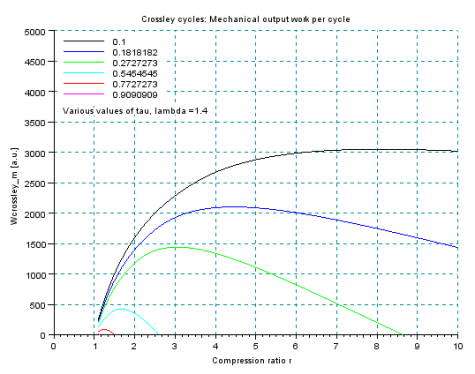| Home |
| Stirling Engines |
| State of the Art |
| Theory |
Theory 7 - Crossley cycles engines
Crossley cycle characteristics
Thermodynamic cycles in real engines do not follow the characteristics of ideal stirling cycles. The results presented previously for the ideal cycle correspond to an idealization of real engines. Due to limited heat transfer, the compression and expansion stages usually do not appear to be isothermal.
Crossley cycles define a complete family of thermodynamic processes having following characteristics:
Two isochore (constant volume) transformations for the cooling and heating stages
Two polytropic (PVγ = constant) transformations for the compression and expansion stages
γ (gamma) is the polytropic coefficient. Two special values of gamma correspond to well know cycles:
γ = 1 gives the ideal Stirling cycle
γ = cp/cv (adiabatic index) gives the "adiabatic stirling" cycle
These two special cases (ideal stirling and adiabatic stirling) bracket the spectrum of reasonable thermodynamic cycles of real engines.

The heat capacity ratio cp/cv (or adiabatic index) of gas is in the range 1,2 up to 1,8. Gazes made of molecules with more degrees of freedom have lower adiabatic index. Higher temperatures also results in lower adiabatic index.
Values of adiabatic index for common gazes are listed below:
| Gas | -180°C |
20°C | 400° | 1000°C |
| H2 | 1.597 | 1.41 | 1.387 | 1.358 |
| He | - | 1.660 | - | - |
| CO2 | - | 1.3 | 1.235 | 1.195 |
| Air (dry) | - | - | 1.393 | 1.365 |
| H2O | - | 1.330 | 1.324 | - |
| Ar | 1.760 | 1.670 | - | - |
| N2 | 1.470 | 1.402 | - | - |
Thermodynamic work of Crossley cycle
Considering an ideal gas, the compression process is expressed as
PVγ = nkBTcVmaxγ-1
Similar relationship occurs for the expansion stage:
PVγ = nkBThVminγ-1
The integration over the complete cycle gives following result:
where τ = Tc/Th and r = Vmax/Vmin
{mosimage}There is an important consequence, especially for low temperature difference stirlings: when compression and expansion are adiabatic (or near adiabatic) the ratio r = Vmax/Vmin has to be small. See following graph showing the thermodynamic work of adiabatic stirling cycles (λ=1.4) for different values of τ (Tc/Th) :

Efficacious condition for Crossley cycle
As discussed in chapter 4, the efficious cycle is characterized by the fact that - for a defined range of buffer pressure - the complete thermodynamic cycle can be performed without any need of forced work (W- = 0). Raw condition is Pmin(Vmin) < Pmax(Vmax), for Crossley cycles this condition reduced to:
τ*r2λ-1 < 1
Mechanical efficiency of Crossley cycles
1) Efficacious Crossley cylce
The mechanical efficiency of optimally buffered efficacious Crossley cycles is similar to the ideal Stirling case:
Emeca_efficacious = E
2) Non-efficacious Crossley cylce
The genereal formula for mechanical efficiency as been discussed in chapter 3:
Emeca = E - (1/E - E)W-/W
Detailing the W-/W expression for optimally buffered Crossley cycle gives following result:

This is the behavior of mechanical efficiency for optimally buffered Crossley cycle engines vs compression ratio r:

Mechanical work output for crossley cycle engines and optimal compression ratio
The work per cycle, available as the output of an optimally buffered non-efficacious Crossley engine is
Wshaft_crossley = Emeca_crossley * Wthermo_crossley
Following graph shows the shaft output for a Crossley cycle engine, assuming λ = 1.4:

As shown in this graph, there is an optimal compression ratio for optimally buffered Crossley engines. This optimal value depends on the value of τ, λ and E. For low temperature differential engines the maximal acceptable compression ratio is much lower than high temperature differential engines.
|
Theory index Theory 1 - Generic
schematic |
